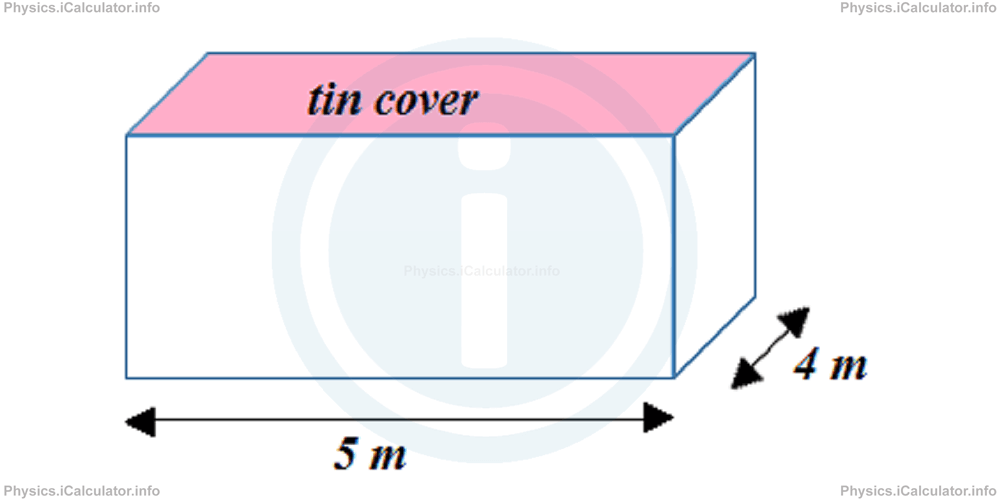Menu
Physics Lesson 13.2.3 - Area Thermal Expansion and Contraction
Please provide a rating, it takes seconds and helps us to keep this resource free for all to use
Welcome to our Physics lesson on Area Thermal Expansion and Contraction, this is the third lesson of our suite of physics lessons covering the topic of Thermal Expansion, you can find links to the other lessons within this tutorial and access additional physics learning resources below this lesson.
Area Thermal Expansion and Contraction
When an object is foil-like, it has two relevant dimensions, length and width. Height is very small to take into consideration. Therefore, another coefficient, known as area thermal expansion coefficient, β is introduced. Mathematically, we ca write β = 2α for the same material, because each dimension experiences the same degree of thermal expansion or contraction. For example, since the linear expansion coefficient of iron is 11.8 × 10-6 K-1 (as discussed in the previous example), the area thermal expansion coefficient of iron is 2 × 11.8 × 10-6 K-1 = 23.6 × 10-6 K-1. The formula is similar to that used for linear thermal expansion, i.e.
where A is the final area and A0 is the original area, and ΔT = T - T0 is the change in temperature.
Example 2
A tin sheet must cover the upper part of a rectangular storage room of floor dimensions 5 m × 4 m as shown in the figure.

If the linear expansion coefficient of tin (in 200 C is 20 × 10-6 K - 1, calculate the minimum area of the tin cover, so that the materials inside the storage room be protected from weather conditions. Take the minimum temperature in winter in the specific region equal to -30°C. Suppose that the setup is made at normal weather conditions, i.e. at 20°C.
Solution 2
First, we calculate the area coefficient of thermal expansion, β. Thus, given that the linear coefficient of thermal expansion for tin is α = 20 × 10-6 K-1, we obtain for the corresponding area coefficient of thermal expansion β:
= 2 × 20 × 10-6 K-1
= 40 × 10-6 K-1
The area to be covered represents the original area A0 in the formula. Thus, we have
= 20 m2
Also, the change in temperature is calculated by taking the difference between final and initial temperature, i.e.
= -30°C - 20°C
= -50°C
Therefore, the area of the tin sheet in winter after experiencing thermal contraction is:
= 20 × [1 + 40 × 10-6 × (-50)]
= 20 × (1 - 2000 × 10-6 )
= 20 × (1 - 2 × 10-3 )
= 20 × (1 - 0.002)
= 20 × 0.998 = 19.96 m2
This means at least other 0.04 m2 of tin are needed at the setup moment to make possible the entire area coverage of the room. Therefore, at least 20 m2 + 0.04 m2 = 20.04 m2 of tin are needed to cover the entire room in order to prevent issues in winter.
You have reached the end of Physics lesson 13.2.3 Area Thermal Expansion and Contraction. There are 7 lessons in this physics tutorial covering Thermal Expansion, you can access all the lessons from this tutorial below.
More Thermal Expansion Lessons and Learning Resources
Whats next?
Enjoy the "Area Thermal Expansion and Contraction" physics lesson? People who liked the "Thermal Expansion lesson found the following resources useful:
- Area Feedback. Helps other - Leave a rating for this area (see below)
- Thermodynamics Physics tutorial: Thermal Expansion. Read the Thermal Expansion physics tutorial and build your physics knowledge of Thermodynamics
- Thermodynamics Revision Notes: Thermal Expansion. Print the notes so you can revise the key points covered in the physics tutorial for Thermal Expansion
- Thermodynamics Practice Questions: Thermal Expansion. Test and improve your knowledge of Thermal Expansion with example questins and answers
- Check your calculations for Thermodynamics questions with our excellent Thermodynamics calculators which contain full equations and calculations clearly displayed line by line. See the Thermodynamics Calculators by iCalculator™ below.
- Continuing learning thermodynamics - read our next physics tutorial: Absorption of Heat
Help others Learning Physics just like you
Please provide a rating, it takes seconds and helps us to keep this resource free for all to use
We hope you found this Physics lesson "Thermal Expansion" useful. If you did it would be great if you could spare the time to rate this physics lesson (simply click on the number of stars that match your assessment of this physics learning aide) and/or share on social media, this helps us identify popular tutorials and calculators and expand our free learning resources to support our users around the world have free access to expand their knowledge of physics and other disciplines.
Thermodynamics Calculators by iCalculator™
- Carnot Engine Efficiency Calculator
- Entropy Calculator
- Gas Laws Calculator
- Molecular Mean Free Path Calculator
- Translational Kinetic Energy Of Gas Calculator
- Root Mean Square Speed Calculator
- Ideal Gas Law Calculator
- Change In The Gas Internal Energy Calculator
- Radiative Heat Transfer Calculator
- Evaporative Heat Transfer Calculator
- Convective Heat Transfer Calculator
- Conductive Heat Transfer Calculator
- Final Temperature Of Mixture Calculator
- Heat Absorbed Or Released Calculator
- Thermal Expansion Calculator
- Temperature Calculator